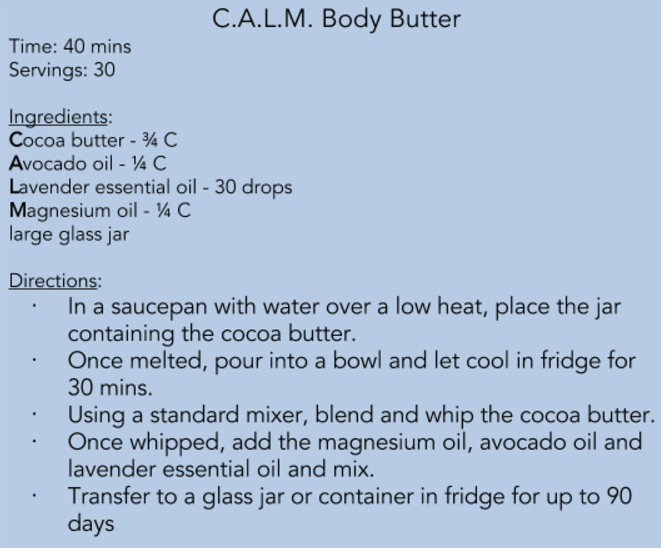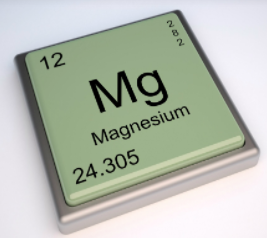Alison Carrington,
Graduate Practitioner, Paua Clinic
Keep CALM and Carry on!
Part 1 in a series looking at Vitamins and Minerals
Magnesium
WHY IS IT SO IMPORTANT?
Magnesium is the fourth most abundant mineral in the body and it has a myriad of important physiological functions such as protein synthesis, muscle contraction, nerve impulse conduction, normal heart rhythm, blood glucose control, blood pressure regulation and energy production. It is involved in over 300 essential enzymatic functions and is necessary for every biological process. Magnesium is one of the four electrolytes or mineral salts in the body, along with potassium, chloride and sodium. Together these minerals help maintain water balance and distribution, kidney and adrenal function, muscle and nerve function and heart function.
An adult body contains approximately 25g magnesium, with about 60% stored in the bones, 20% in skeletal muscle, 19% soft tissue. Less than 1% of total magnesium is found in blood serum, which is why magnesium status is difficult to measure through blood tests. The magnesium stores are kept under tight control by the kidneys. About 120mg magnesium is excreted through urine each day, and the kidneys adjust this amount when magnesium status is low.
DEFICIENCY SIGNS, SYMPTOMS & CONDITIONS
When reduced intakes or increased losses of magnesium occur, there is an increased susceptibility to a variety of diseases and conditions, including heart disease, high blood pressure, kidney stones, cancer, insomnia, PMS and menstrual cramps. Also:
- Muscular weakness and spasms
- Numbness, tingling and cramps
- Confusion
- Hyper-irritability and excitability
- Depression
- Dysregulation of biorhythms including some mental health disorders and insomnia
- Nausea and vomiting
- Migraines and headaches
- Anorexia and weight-loss
- Personality changes
- Vertigo
- Lethargy
- Cardiac arrhythmia, tetany (spasms) and convulsions can occur if a deficiency is prolonged.
Deficiency is common in both acute and terminally ill patients, and is the result of a combination of an insufficient dietary intake and/or intestinal malabsorption and increased magnesium depletion. Magnesium deficiency due to low dietary intake in an otherwise-healthy person, however, is not common as the kidneys limit urinary excretion of this mineral. Habitually low intakes or excessive losses of magnesium due to certain health conditions, chronic alcoholism, and/or the use of certain medications can lead to magnesium deficiency.
Magnesium is a natural “antagonist” to calcium, meaning that they work in opposition with each other. For example when magnesium levels are low, the muscle and nerve functions of the body are reduced, and muscle cramps can result. This happens because muscles use calcium to contract, while magnesium helps them relax. Correct mineral balance allows the muscles to cycle naturally; the ideal magnesium-to-calcium ratio being 1:1. Excessive amounts of calcium, with no equaliser of magnesium, can produce a spasm of the coronary arteries, reducing the flow of blood and oxygen to the heart, leading to a heart attack and sudden death. The left ventricle of the heart requires a lot of magnesium, and without sufficient amounts, the heart cannot function properly. The body will take magnesium from muscles and bones to make sure there is enough for the heart.
DIETARY SOURCES OF MAGNESIUM
One of the best ways to ensure you have enough magnesium is by eating whole foods. It is difficult to get the Recommended Daily Intake (RDI) of magnesium from a diet consisting of processed food, as the manufacturing processes deplete this important mineral. Green leafy vegetables like spinach and Swiss chard are excellent sources of magnesium, also legumes, cocoa, nuts and seeds such as almonds, pumpkin seeds, sunflower seeds and sesame seeds. Avocados are also a good source.
RECOMMENDED DIETARY INTAKES FOR MAGNESIUM:
Men 19-30 years: 400mg/day
>30 years: 420mg/day
Women 19-30 years: 310mg/day
>30 years: 320mg/day
For a more information on New Zealand Recommended Dietary Intakes and food sources of macronutrients, vitamins and minerals, including a PDF version, please refer to:
https://www.nrv.gov.au/nutrients
Using magnesium oil is a great way of absorbing magnesium, as it does not need to be digested. This Body Butter, suitable as a moisturiser or to soothe aching muscles, is made with
Cocoa Butter, Avocado oil, Lavender and Magnesium oil (CALM).
References
Axe, J. (2017). Homemade CALM Magnesium Body Butter – Dr. Axe. Dr. Axe. https://draxe.com/homemade-magnesium-body-butter/
Braun, L., & Cohen, M. (2011). Herbs and Natural Supplements (3rd ed.). Sydney: Churchill Livingstone.
Magnesium | Nutrient Reference Values. (2014). nrv.gov.au. https://www.nrv.gov.au/nutrients/magnesium
Murray, M., Pizzorno, J., & Pizzorno, L. (2005). The encyclopaedia of healing foods (1st ed.). New York: Atria.
Office of Dietary Supplements – Magnesium. (2016). Ods.od.nih.gov. https://ods.od.nih.gov/factsheets/Magnesium-HealthProfessional/
C.A.L.M. Body Butter






